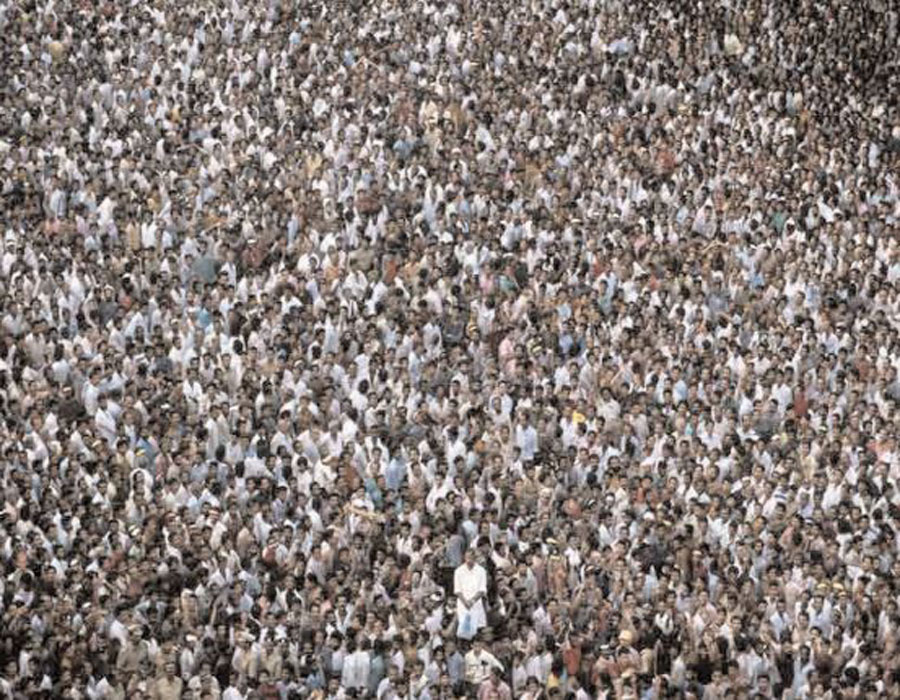In the early 1930s, when we were born, the world population was just 2 billion; now it is more than two and a half times as large and still growing rapidly. The population of the United States is increasing much more slowly than the world average, but it has more than doubled in only six decades -- from 120 million in 1928 to 250 million in 1990. Such a huge population expansion within two or three generations can by itself account for a great many changes in the social and economic institutions of a society. It also is very frightening to those of us who spend our lives trying to keep track of the implications of the population explosion.
This sequel to Paul Ehrlich's 1968 landmark bestseller The Population Bomb examines the critical choices we face today and proposes an agenda for the 1990s to avoid global ecocide. The Population Explosion vividly describes how the Earth's population, growing by 95 million people a year, is rapidly depleting the planet's resources, resulting in famine, global warming, acid rain, and other major problems. Paul and Anne Ehrlich also clearly and concisely point to immediate action that will lessen the threat of ruin and begin to build a more peaceful, sane, and secure world.
A SLOW START
One of the toughest things for a population biologist to reconcile is the contrast between his or her recognition that civilization is in imminent serious jeopardy and the modest level of concern that population issues generate among the public and even among elected officials.
Much of the reason for this discrepancy lies in the slow development of the problem. People aren't scared because they evolved biologically and culturally to respond to short-term "fires" and to tune out long-term "trends" over which they had no control. Only if we do what doesn't come naturally -- if we determinedly focus on what seem to be gradual or nearly imperceptible changes -- can the outlines of our predicament be perceived clearly enough to be frightening.
Our own species, Homo sapiens, evolved a few hundred thousand years ago. Some ten thousand years ago, when agriculture was invented, probably no more than five million people inhabited Earth -- fewer than now live in the San Francisco Bay Area. Even at the time of Christ, two thousand years ago, the entire human population was roughly the size of the population of the United States today; by 1650 there were only 500 million people and in 1850 only a little over a billion. Since there are now well past 5 billion people, the vast majority of the population explosion has taken place in less than a tenth of one percent of the history of Homo sapiens.
This is a remarkable change in the abundance of a single species. After an unhurried pace of growth over most of our history, the expansion of the population accelerated during the Industrial Revolution and really shot up after 1950. Since the mid-century, the human population has been growing at annual rates ranging from about 1.7 to 2.1 percent per year, doubling in forty years or less. Some groups have grown significantly faster; the population of the African nation of Kenya^ was estimated to be increasing by over 4 percent annually during the 1980s -- a rate that if continued would double the nation's population in only seventeen years. That rate did continue for over a decade and only recently has shown slight signs of slowing. Meanwhile, other nations, such as those of northern Europe, have grown much more slowly in recent decades.
But even the highest growth rates are still slow-motion changes compared to events we easily notice and react to. A car swerving at us on the highway is avoided by actions taking a few
DEMOGRAPHIC FACTS
Ten Most Populous Countries
- China
Population: 1,338,612,968 (Excluding Hong Kong, Taiwan, and Macau)
Percentage of World Population: 19.6
Did you know?
- In 1979, China introduced a one-child policy to curb population growth. About 36 percent of China's population is currently subject to this policy.
- China's biggest cities, Shanghai and Beijing, each count more than 17 million people in their respective municipalities.
- Between 1978 and 2005, China's level of urbanization increased from 17.4 to 41.8 percent. (Photo: Reuters)
- India
Population: 1,163,408,098
Percentage of World Population: 17.1
Did you know?
- India is a remarkably diverse country: It is estimated that only the continent of Africa exceeds the linguistic, cultural, and genetic diversity of India.
- There are more than two thousand ethnic groups in India.
- More than two hundred languages are spoken in India, 22 of them are official languages.
- United States
Population: 300,009,000
Percentage of World Population: 4.4
Demographic Facts:
- Every eight seconds, a baby is born in the U.S. Every twelve seconds, someone dies.
- More than 60 percent of all Americans live in one of the 51 metropolitan areas with a population of more than 1 million people.
- The population growth in the U.S. is among the highest in industrialized countries. In 2050, the U.S. population could reach 439 million.
- Indonesia
Population: 230,168,000
Percentage of World Population: 3.4
Did you know?
- Indonesia's 230 million people live on about 6,000 islands scattered across both sides of the equator.
- Indonesia has the largest Muslim population in the world. About 86 percent of Indonesia's population is Muslim.
- The island of Java is one of the most densely populated areas in the world. More than 107 million people live in an area that is the size of New York State.
- Brazil
Population: 191,109,937
Percentage of World population: 2.8
Did you know?
- The largest cities in Brazil are Sao Paulo (19.6 million people) and Rio de Janeiro (7 million people).
- The ancestors of most Brazilians are indigenous people, Portuguese colonists, and African slaves.
- Today, Brazil has the biggest Japanese (1.6 million people) and Italian populations (25 million people) outside their home
- Pakistan
Population: 176,242,949
Percentage of World Population: 2.6
Did you know?
- Agriculture and related activities engage 42 percent of the Pakistan workforce.
- Pakistan has a relatively high fertility rate of more than 3 children per woman.
- Pakistan has a very young population: The median age is 20 years. About half of the population are younger than 20 years; only 4 percent are older than 65. (Photo: Reuters)
- Bangladesh
Population: 156,050,883
Percentage of World Population: 2.3
Did you know?
- The country's name derives from the linguistic and ethnic group "Bengali". Ninety-eight per cent of Bangladesh's population are Bengali.
- Thirty-six percent of the population survives on a per capita income below one dollar a day.
- Bangladesh has a very low literacy rate: Only 48 percent of the population older than 15 can read and write.
- Nigeria
Population: 148,093,000
Percentage of World Population: 2.2
Did you know?
- Nigeria has a high population growth rate of 2 percent. About one out of every four Africans is Nigerian.
- Life expectancy in Nigeria is 47 years, the median age is 19 years.
- There are more than 250 ethnic groups and 510 living languages in Nigeria.
- Russia
Population: 141,824,280
Percentage of World Population: 2.1
Did you know?
- Russia ranks 9th in terms of population, but is the largest country by land size with about 17 million square kilometers (6,592,800 sq mi).
- Marriage rates increased from 6,2 marriages per 1,000 people in the year 2000 to 8,9 marriages per 1,000 people in 2007. t Russia has the biggest gap between male and female life expectancy: While females live 73 years on average, males live only about 59 years. (Photo: Reuters)
- Japan
Population: 127,078,679
Percentage of World Population: 1.9
Did you know?
- Japan has a high population density. On average, Japan counts 337 people per square kilometer.
- The average life expectancy in Japan is 82 years, one of the highest in the world. Currently, there are over 35,000 people in Japan who are older than 100.
- Due to low fertility rates, Japan's population could drop to 100 million by 2050; by 2100, this number could fall to 64 million.
This sequel to Paul Ehrlich's 1968 landmark bestseller The Population Bomb examines the critical choices we face today and proposes an agenda for the 1990s to avoid global ecocide.
The Population Explosion vividly describes how the Earth's population, growing by 95 million people a year, is rapidly depleting the planet's resources, resulting in famine, global warming, acid rain, and other major problems. Paul and Anne Ehrlich also clearly and concisely point to immediate action that will lessen the threat of ruin and begin to build a more peaceful, sane, and secure world.
A SLOW START
One of the toughest things for a population biologist to reconcile is the contrast between his or her recognition that civilization is in imminent serious jeopardy and the modest level of concern that population issues generate among the public and even among elected officials.
Much of the reason for this discrepancy lies in the slow development of the problem. People aren't scared because they evolved biologically and culturally to respond to short-term "fires" and to tune out long-term "trends" over which they had no control. Only if we do what doesn't come naturally -- if we determinedly focus on what seem to be gradual or nearly imperceptible changes -- can the outlines of our predicament be perceived clearly enough to be frightening.
Our own species, Homo sapiens, evolved a few hundred thousand years ago. Some ten thousand years ago, when agriculture was invented, probably no more than five million people inhabited Earth -- fewer than now live in the San Francisco Bay Area. Even at the time of Christ, two thousand years ago, the entire human population was roughly the size of the population of the United States today; by 1650 there were only 500 million people and in 1850 only a little over a billion. Since there are now well past 5 billion people, the vast majority of the population explosion has taken place in less than a tenth of one percent of the history of Homo sapiens.
This is a remarkable change in the abundance of a single species. After an unhurried pace of growth over most of our history, the expansion of the population accelerated during the Industrial Revolution and really shot up after 1950. Since the mid-century, the human population has been growing at annual rates ranging from about 1.7 to 2.1 percent per year, doubling in forty years or less. Some groups have grown significantly faster; the population of the African nation of Kenya was estimated to be increasing by over 4 percent annually during the 1980s -- a rate that if continued would double the nation's population in only seventeen years. That rate did continue for over a decade and only recently has shown slight signs of slowing. Meanwhile, other nations, such as those of northern Europe, have grown much more slowly in recent decades.
But even the highest growth rates are still slow-motion changes compared to events we easily notice and react to. A car swerving at us on the highway is avoided by actions taking a few seconds. The Alaskan oil spill caused great public indignation but faded from the media and the consciousness of most people in a few months. America's participation in World War II spanned less than four years. During the last four years, even Kenya's population grew by only about 16 percent--a change hardly perceptible locally, let alone from a distance. In four years, the world population expands only a little more than 7 percent. Who could notice that? Precipitous as the population explosion has been in historical terms, it is occurring at a snail's pace in an individual's perception. It is not an event, it is a trend that must be analyzed in order for its significance to be appreciated.
EXPONENTIAL GROWTH
The time it takes a population to double in size is a dramatic way to picture rates of population growth, one that most of us can understand more readily than percentage growth rates. Human populations have often grown in a pattern described as "exponential." Exponential growth occurs in bank accounts when interest is left to accumulate and earns interest. Exponential growth occurs in populations because children, the analog of interest, remain in the population and themselves have children.
A key feature of exponential growth is that it often seems to start slowly and finish fast. A classic example used to illustrate this is the pondweed that doubles each day the amount of pond surface covered and is projected to cover the entire pond in thirty days. The question is, how much of the pond will be covered in twenty-nine days? The answer, of course, is that just half of the pond will be covered in twenty-nine days. The weed will then double once more and cover the entire pond the next day. As this example indicates, exponential growth contains the potential for big surprises.
The limits to human population growth are more difficult to perceive than those restricting the pond weed's growth. Nonetheless, like the pondweed, human populations grow in a pattern that is essentially exponential, so we must be alert to the treacherous properties of that sort of growth. The key point to remember is that a long history of exponential growth in no way implies a long future of exponential growth. What begins in slow motion may eventually overwhelm us in a flash.
The last decade or two has seen a slight slackening in the human population growth rate -- a slackening that has been prematurely heralded as an "end to the population explosion." The slowdown has been only from a peak annual growth rate of perhaps 2.1 percent in the early 1960s to about 1.8 percent in 1990. To put this change in perspective, the population's doubling time has been extended from thirty-three years to thirty-nine. Indeed, the world population did double in the thirty-seven years from 1950 to 1987. But even if birth rates continue to fall, the world population will continue to expand (assuming that death rates don't rise), although at a slowly slackening rate, for about another century. Demographers think that growth will not end before the population has reached 10 billion or more.
So, even though birth rates have declined somewhat, Homo sapiens is a long way from ending its population explosion or avoiding its consequences. In fact, the biggest jump, from 5 to 10 billion in well under a century, is still ahead. But this does not mean that growth couldn't be ended sooner, with much smaller population size, if we -- all of the world's nations -- made up our minds to do it. The trouble is, many of the world's leaders and perhaps most of the world's people still don't believe that there are compelling reasons to do so. They are even less aware that if humanity fails to act, nature may end the population explosion for us -- in very unpleasant ways -- well before 10 billion is reached.
Those unpleasant ways are beginning to be perceptible. Humanity in the 1990s will be confronted by more and more intransigent environmental problems, global problems dwarfing those that worried us in the late 1960s. Perhaps the most serious is that of global warming, a problem caused in large part by population growth and overpopulation. It is not clear whether the severe drought in North America, the Soviet Union, and China in 1988 was the result of the slowly rising surface temperature of Earth, but it is precisely the kind of event that climatological models predict as more and more likely with continued global warming. In addition to more frequent and more severe crop failures, projected consequences of the warming include coastal flooding, desertification, the creation of as many as 300 million environmental refugees, alteration of patterns of dis-ease, water shortages, general stress on natural ecosystems, and synergistic interactions among all these factors.
Continued population growth and the drive for development in already badly overpopulated poor nations will make it exceedingly difficult to slow the greenhouse warming -- and impossible to stop or reverse it -- in this generation at least. And, even if the warming should miraculously not occur, contrary to accepted projections, human numbers are on a collision course with massive famines anyway.
MAKING THE POPULATION CONNECTION
Global warming, acid rain, depletion of the ozone layer, vulnerability to epidemics, and exhaustion of soils and groundwater are all, as we shall see, related to population size. They are also clear and present dangers to the persistence of civilization. Crop failures due to global warming alone might result in the premature deaths of a billion or more people in the next few decades, and the AIDS epidemic could slaughter hundreds of millions. Together these would constitute a harsh "population control" program provided by nature in the face of humanity's refusal to put into place a gentler program of its own. We shouldn't delude ourselves: the population explosion will come to an end before very long. The only remaining question is whether it will be halted through the humane method of birth control, or by nature wiping out the surplus. We realize that religious and cultural opposition to birth control exists throughout the world, but we believe that people simply don't understand the choice that such opposition implies. Today, anyone opposing birth control is unknowingly voting to have the human population size controlled by a massive increase in early deaths.
Of course, the environmental crisis isn't caused just by expanding human numbers. Burgeoning consumption among the rich and increasing dependence on ecologically unsound technologies to supply that consumption also play major parts. This allows some environmentalists to dodge the population issue by emphasizing the problem of malign technologies. And social commentators can avoid commenting on the problem of too many people by focusing on the serious maldistribution of affluence.
But scientists studying humanity's deepening predicament recognize that a major factor contributing to it is rapidly worsening overpopulation. The Club of Earth, a group whose members all belong to both the U.S. National Academy of Sciences and the American Academy of Arts and Sciences, released a statement in September 1988 that said in part: Arresting global population growth should be second in importance only to avoiding nuclear war on humanity's agenda. Overpopulation and rapid population growth are intimately connected with most aspects of the current human predicament, including rapid depletion of nonrenewable resources, deterioration of the environment (including rapid climate change), and increasing international tensions.
But even in that narrow context, the assertion is wrong. Suppose food was distributed equally. If everyone in the world ate as Americans do, less than half the present world population could be fed on the record harvests of 1985 and 1986.
Of course, everyone doesn't have to eat like Americans.
About a third of the world's grain harvest -- the staples of the human feeding base -- is fed to animals to produce eggs, milk, and meat for American-style diets. Wouldn't feeding that grain directly to people solve the problem? If everyone were willing to eat an essentially vegetarian diet, that additional grain would allow perhaps a billion more people to be fed with 1986 production.
Would such radical changes solve the world food problem? Only in the very short term. An additional billion people are slated to be with us by the end of the century. Moreover, by the late 1980s, humanity already seemed to be encountering trouble maintaining the production levels of the mid-1980s, let alone keeping up with population growth. The world grain harvest in 1988 was some 10 percent below that of 1986. And there is little sign that the rich are about to give up eating animal products.
So there is no reasonable way that the hunger problem can be called "only" one of distribution, even though redistribution of food resources would greatly alleviate hunger today. Unfortunately, an important truth, that mal-distribution is a cause of hunger now, has been used as a way to avoid a more important truth -- that overpopulation is critical today and may well make the distribution question moot tomorrow.
The food problem, however, attracts little immediate concern among well-fed Americans, who have no reason to be aware of its severity or extent. But other evidence that could make everyone face up to the seriousness of the population dilemma is now all around us since problems to which overpopulation and population growth make major contributions are worsening at a rapid rate. They often appear on the evening news, although the population connection is almost never made.
Consider the television pictures of barges loaded with garbage wandering like The Flying Dutchman across the seas, and news stories about "no room at the dump." They are showing the results of the interaction between too many affluent people and the environmentally destructive technologies that support that affluence. Growing opportunities to swim in a mixture of sewage and medical debris off American beaches can be traced to the same source. Starving people in sub-Saharan Africa are victims of drought, defective agricultural policies, and overpopulation of both people and domestic animals -- with warfare often dealing the final blow. All of the above are symptoms of humanity's massive and growing negative impact on Earth's life-support systems.
RECOGNIZING THE POPULATION PROBLEM
The average person, even the average scientist, seldom makes the connection between such seemingly disparate events and the population problem, and thus remains unworried. To a degree, this failure to put the pieces together is due to a taboo against frank discussion of the population crisis in many quarters, a taboo generated partly by pressures from the Catholic hierarchy and partly by other groups who are afraid that dealing with population is-sues will produce socially damaging results.
Many people on the political left are concerned that focusing on overpopulation will divert attention from crucial problems of social justice (which certainly need to be addressed in addition to the population problem). Often those on the political right fear that dealing with overpopulation will encourage abortion (it need not) or that halting growth will severely damage the economy (it could, if not handled properly). And people of varied political persuasions who are unfamiliar with the magnitude of the population problem believe in a variety of farfetched technological fixes -- such as colonizing outer space -- that they think will allow the need for regulating the size of the human population to be avoided forever.
Even the National Academy of Sciences avoided mentioning controlling human numbers in its advice to President Bush on how to deal with global environmental change. Although Academy members who are familiar with the issue are well aware of the critical population component of that change, it was feared that all of the Academy's advice would be ignored if recommendations were included about a subject taboo in the Bush administration. That strategy might have been correct, considering Bush's expressed views on abortion and considering the administration's weak appointments in many environmentally sensitive positions. After all, the Office of Management and Budget even tried to suppress an expert evaluation of the potential seriousness of global warming by altering the congressional testimony of a top NASA scientist, James Hansen, to conform with the administration's less urgent view of the problem.
All of us naturally lean toward the taboo against dealing with population growth. The roots of our aversion to limiting the size of the human population are as deep and pervasive as the roots of human sexual behavior. Through billions of years of evolution, our reproducing other members of your population was the name of the game. It is the very basis of natural selection, the driving force of the evolutionary process. Nonetheless, the taboo must be uprooted and discarded.
OVERCOMING THE TABOO
There is no more time to waste; in fact, there wasn't in 1968 when The Population Bomb was published. Human inaction has already condemned hundreds of millions more people to premature deaths from hunger and disease. The population connection must be made in the public mind. Action to end the population explosion humanely and start a gradual population decline must become a top item on the human agenda: the human birth rate must be lowered to slightly below the human death rate as soon as possible. There still may be time to limit the scope of the impending catastrophe, but not much time. Ending the population ex-plosion by controlling births is necessarily a slow process. Only nature's cruel way of solving the problem is likely to be swift.
Of course, if we do wake up and succeed in controlling our population size, that will still leave us with all the other thorny problems to solve. Limiting human numbers will not alone end warfare, environmental deterioration, poverty, racism, religious prejudice, or sexism; it will just buy us the opportunity to do so. As the old saying goes, whatever your cause, it's a lost cause without population control.
America and other rich nations have a clear choice today. They can continue to ignore the population problem and their own massive contributions to it. Then they will be trapped in a downward spiral that may well lead to the end of civilization in a few decades. More frequent droughts, more damaged crops and famines, more dying forests, more smog, more international conflicts, more epidemics, more gridlock, more drugs, more crime, more sewage swimming, and other extreme unpleasantness will mark our course. It is a route already traveled by too many of our less fortunate fellow human beings.
Or we can change our collective minds and take the measures necessary to lower global birth rates dramatically. People can learn to treat growth as cancer like the disease it is and move toward a sustainable society. The rich can make helping the poor an urgent goal, instead of seeking more wealth and useless military advantage over one another. Then humanity might have a chance to manage all those other seemingly intractable problems. It is a challenging prospect, but at least it will give our species a shot at creating a decent future for itself. More immediately and concretely, taking action now will give our children and their children the possibility of decent lives.
All too often, overpopulation is thought of simply as crowding: too many people in a given area, too high a population density. For instance, the deputy editor in chief of Forbes magazine pointed out recently, in connection with a plea for more population growth in the United States: "If all the people from China and India lived in the continental U.S. (excluding Alaska), this country would still have a smaller population density than England, Holland, or Belgium."
The appropriate response is "So what?" Density is generally irrelevant to questions of overpopulation. For instance, if brute density were the criterion, one would have to conclude that Africa is "underpopulated," because it has only 55 people per square mile, while Europe (excluding the USSR) has 261 and Japan 857. A more sophisticated measure would take into consideration the amount of Africa not covered by desert or "impenetrable" forests. This more habitable portion is just a little over half the continent's area, giving an effective population density of 117 per square mile. That's still only about a fifth of that in the United Kingdom. Even by 2020, Africa's effective density is projected to grow to only about that of France today (266), and few people would consider France excessively crowded or overpopulated.
When people think of crowded countries, they usually contemplate places like the Netherlands (1,031 per square mile), Taiwan (1,604), or Hong Kong (14,218). Even those don't necessarily signal overpopulation--after all, the Dutch seem to be thriving, and doesn't Hong Kong have a booming economy and fancy hotels? In short, if density were the standard of overpopulation, few nations (and certainly not Earth itself) would be likely to be considered overpopulated in the near future. The error, we repeat, lies in trying to define overpopulation in terms of density; it has long been recognized that density per se means very little.
The key to understanding overpopulation is not population density but the number of people in an area relative to its resources and the capacity of the environment to sustain human activities; that is, to the area's carrying capacity. When is an area overpopulated? When its population can't be maintained without rapidly depleting nonrenewable resources (or converting renewable resources into nonrenewable ones) and without degrading the capacity of the environment to support the population. In short, if the long-term carrying capacity of an area is clearly being degraded by its current human occupants, that area is overpopulated.
By this standard, the entire planet and virtually every nation are already vastly overpopulated. Africa is overpopulated now because, among other indications, its soils and forests are rapidly being depleted and that implies that its carrying capacity for human beings will be lower in the future than it is now. The United States is overpopulated because it is depleting its soil and water resources and contributing mightily to the destruction of global environmental systems. Europe, Japan, the Soviet Union, and other rich nations are over-populated because of their massive contributions to the carbon dioxide build-up in the atmosphere, among many other reasons. Almost all the rich nations are overpopulated because they are rapidly drawing down stocks of resources around the world. They don't live solely on the land in their own nations.... they are spending their capital with no thought for the future.
This "carrying capacity" definition of overpopulation is the one used in this book. It is important to understand that under this definition a condition of over-population might be corrected with no change in the number of people. For instance, the impact of today's 665 million Africans on their resources and environment theoretically might be reduced to the point where the continent would no longer be overpopulated. To see whether this would be possible, population growth would have to be stopped . . .
Similarly, dramatic changes in American lifestyle might suffice to end overpopulation in the United States without a large population reduction.








 OpinionExpress.In
OpinionExpress.In















Comments (0)